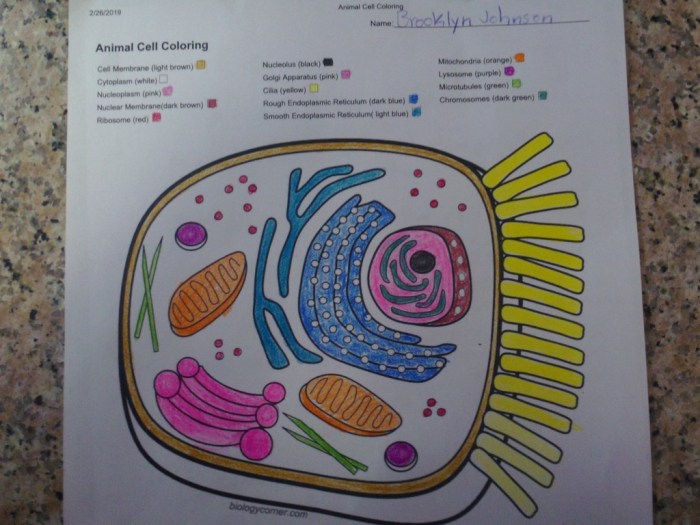Worksheet Design & Structure: Animal And Plant Cell Coloring Worksheet Key

Animal and plant cell coloring worksheet key – This section details the design and structure of a coloring worksheet featuring both animal and plant cells, along with a corresponding answer key. The aim is to create a visually appealing and informative resource for learning about cell biology. The design emphasizes clarity and ease of use, making it suitable for a range of ages and learning styles.
The worksheet and key will utilize HTML tables to organize information effectively. A four-column responsive design ensures readability across various devices. The color palette and font choices are carefully selected to enhance the learning experience, promoting engagement and retention.
Worksheet Layout
The worksheet will be designed to be visually engaging and informative. It will feature two large illustrations: one representing an animal cell and the other a plant cell. Each cell will be presented with its organelles clearly Artikeld and numbered for easy identification. These numbered organelles will correspond to the entries in the key table. The illustrations will be simple yet detailed, avoiding overly complex drawings that might overwhelm young learners.
A vibrant, yet calming, color palette will be used, with distinct colors assigned to each organelle. For example, the nucleus could be a soft pink, the mitochondria a sunny yellow, and the chloroplast (in the plant cell only) a cheerful lime green. A clear, easy-to-read sans-serif font like Arial or Calibri will be used throughout.
| Organelle Number | Organelle Name | Animal Cell? | Plant Cell? |
|---|---|---|---|
| 1 | Cell Membrane | Yes | Yes |
| 2 | Cytoplasm | Yes | Yes |
| 3 | Nucleus | Yes | Yes |
| 4 | Mitochondria | Yes | Yes |
| 5 | Ribosomes | Yes | Yes |
| 6 | Endoplasmic Reticulum (ER) | Yes | Yes |
| 7 | Golgi Apparatus | Yes | Yes |
| 8 | Lysosomes | Yes | Yes |
| 9 | Vacuole | Yes (small) | Yes (large, central) |
| 10 | Cell Wall | No | Yes |
| 11 | Chloroplasts | No | Yes |
Answer Key Layout, Animal and plant cell coloring worksheet key
The answer key will mirror the structure of the worksheet, providing a clear and concise guide for coloring. It will use a similar four-column responsive HTML table. Each row will correspond to an organelle from the worksheet, indicating the assigned color and providing a brief description of its function. The descriptions will be simple and age-appropriate, focusing on the key roles of each organelle.
The font and color scheme will be consistent with the worksheet, ensuring visual harmony.
| Organelle Number | Organelle Name | Assigned Color | Function |
|---|---|---|---|
| 1 | Cell Membrane | Light Blue | Controls what enters and leaves the cell. |
| 2 | Cytoplasm | Light Green | Gel-like substance filling the cell; location of many cellular processes. |
| 3 | Nucleus | Pink | Contains the cell’s genetic material (DNA). |
| 4 | Mitochondria | Yellow | Powerhouse of the cell; produces energy. |
| 5 | Ribosomes | Purple | Make proteins. |
| 6 | Endoplasmic Reticulum (ER) | Orange | Network of membranes involved in protein and lipid synthesis. |
| 7 | Golgi Apparatus | Light Brown | Processes and packages proteins. |
| 8 | Lysosomes | Dark Purple | Break down waste materials. |
| 9 | Vacuole | Light Purple | Stores water and other materials. |
| 10 | Cell Wall | Dark Green | Provides support and protection to the plant cell. |
| 11 | Chloroplasts | Lime Green | Carry out photosynthesis; produce food for the plant cell. |
Understanding the differences between animal and plant cell structures is made easier with a coloring worksheet key. This helps visualize the organelles, and for a broader understanding of the animal world, you might enjoy exploring the diverse creatures featured in these animal kingdom coloring pages. Returning to the cellular level, the worksheet key provides a valuable tool for reinforcing learning about animal and plant cell components.

